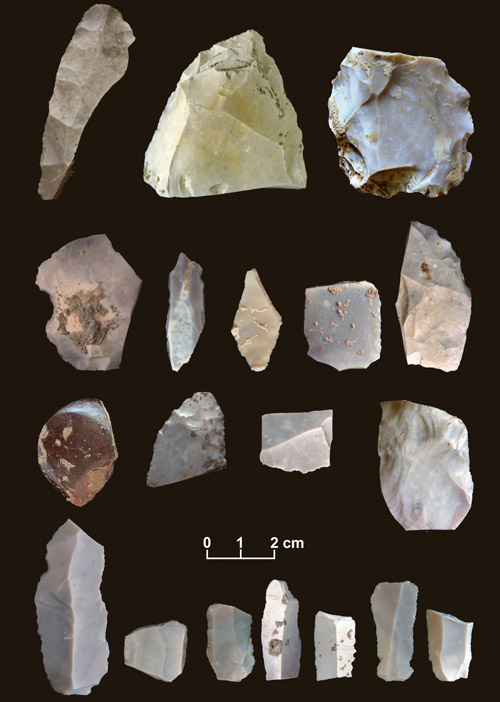WASHINGTON — The discovery of ancient stone tools at an archaeological dig in Texas could push back the presence of humans in North America, perhaps by as much as 2,500 years.
Thousands of artifacts dating to between 13,200 and 15,500 years ago were uncovered by researchers led by Michael R. Waters of Texas A&M University. They report the discovery in Friday’s edition of the journal Science.
The find was located 5 feet below materials left by the well-known Clovis culture, which was once thought to have been the first American settlers around 13,000 years ago.
It was “like finding the Holy Grail,” Waters said in a telephone interview. To find what appears to be a large open-air campsite “is really gratifying. Lucky and gratifying.”
The trove of 15,528 artifacts, including chipping debris from working stones and 56 tools such as blades, scrapers and choppers, was found in the Buttermilk Creek complex near Austin.
The location is the oldest credible archaeological site in North America, Waters said at a briefing. The artifacts were found in an 8-inch (20 centimeter) layer beneath 5 feet (1.5 meters) of earth and other material from later human occupation at the site.
The small tools were “a mobile tool kit,” Waters said, and of the type that could have led to the later development of the fluted points that trademark Clovis technology.
While there are other pre-Clovis sites across the country, Waters said the new find included significantly more artifacts than the others.
Anthropologist Tom D. Dillehay of Vanderbilt University, who was not part of the research team, said he is concerned that the separation of layers at the site “appears not to be as clear as the authors would have us believe.”
University of Oregon archaeologist Dennis L. Jenkins said he was also initially skeptical of the find, commenting “it would have been a hard sell” from many other researchers.
Jenkins, who three years ago reported discovery of 14,000-year-old evidence of human DNA in a cave in Oregon, said he was concerned that settling or rodents had mixed up the specimens in Texas.
But, he said, Waters’ team had done “incredible, meticulous scientific work.” “I believe he’s made the case,” he said.
Jenkins said he would have preferred carbon-dating of the specimens, but that couldn’t be done because there was no organic material to be tested in the newly found layer.
Steven L. Forman, of the University of Illinois, Chicago, a co-author of the paper, said the team used luminescence dating which can determine when the material was last exposed to light. They took samples by hammering black, sealed copper pipe into the layers.
In a separate paper in the journal, researchers report evidence of early humans in south India more than a million years ago.
Researchers discovered more than 3,500 quartzite tools of the distinct Acheulian design used by the earliest humans in Africa starting more than 1.5 million years ago. They dated the tools to at least 1.07 million years old and some possibly 1.51 million years old.
The discovery at a site called Attirampakkam in the Kortallayar river basin helps anthropologists understand the spread of ancient people from Africa into Asia. Leading the research team was Shanti Pappu of the Sharma Centre for Heritage Education in Tamil Nadu, India.
The find is unprecedented for archaeological studies in India, said archaeologist Michael Petraglia of the University of Oxford, England, who was not part of the research team.
He said it could mean that early humans migrated out of Africa earlier than the oft-cited 1.4 million years ago, carrying the tools to southern Asia.
“The suggestion that this occurred at around 1.5 million years ago is simply staggering,” he said.
Send questions/comments to the editors.



Success. Please wait for the page to reload. If the page does not reload within 5 seconds, please refresh the page.
Enter your email and password to access comments.
Hi, to comment on stories you must . This profile is in addition to your subscription and website login.
Already have a commenting profile? .
Invalid username/password.
Please check your email to confirm and complete your registration.
Only subscribers are eligible to post comments. Please subscribe or login first for digital access. Here’s why.
Use the form below to reset your password. When you've submitted your account email, we will send an email with a reset code.